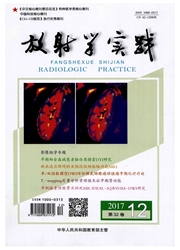

 中文摘要:
中文摘要:
目的:评价三维动脉自旋标记(3D-ASL)在缺血性脑血管病中的应用价值。方法:纳入本研究的缺血性脑血管病患者30例,其中急性脑梗死13例,短暂性脑缺血发作(TIA)17例。所有研究对象均行常规MRI、DWI及3D-ASL扫描。观察并分析所有患者的DWI及ASL全脑血流量(ASL-CBF)图有无异常。选择13例脑梗死患者的梗死最大层面,采用手动勾画法分别在DWI、ASL-CBF图上测量梗死面积和灌注异常面积,采用两独立样本t检验比较两者间的差异。结果:17例TIA在DWI图上均无阳性发现,12例在ASL-CBF图上表现为大小不等灌注减低区。2例TIA复查时可见ASL-CBF图上血流灌注部分恢复。13例脑梗死的DWI图上见大小不等的高信号,梗死面积为(1026.54±295.50)mm2,ASL-CBF图上灌注异常面积为(2901.77±415.94)mm2,并可观察到高、低灌注状态。ASL-CBF图上灌注异常面积大于DWI图上梗死面积,且差异有统计学意义(t=3.675,P=0.001)。结论:3D-ASL可全面反映缺血性脑血管病的血流灌注状态,动态观察血流灌注恢复情况,有利于及时指导临床治疗并判断预后。
 英文摘要:
英文摘要:
Objective:To evaluate the application of three-dimension arterial spin labeling (3D-ASL) in observing the brain perfusion in patients with ischemic cerebrovascular disease. Methods:A total of 30 cases with acute cerebral infarction in 13 cases and with transient ischemic attack (TIA) in 17 were included in this study. All subjects underwent conventional MRI,DWI and 3D-ASL scanning. The DWI and ASL-CBF maps of all patients were observed and analyzed. The lesion area and its CBF value were measured on DWI and ASL-CBF maps in the 13 patients with cerebral infarction by using the manual method. Two independent samples t-test was used to compare the lesion area between DWI and CBF maps. Results: 13 patients with acute cerebral infarction showed hyperintensity on DWI maps, the infarcted area was (1026.54 ± 295.50)mm2 , and the abnormal area on ASL-CBF maps was (2901.77±415.94)ram2 ,and high and low perfusion were displayed in ASL maps. The abnormal area on ASL-CBF maps was significantly larger than that on the DWI maps (t=3. 675 ,P=0. 001). 17 patients with transient ischemic attack had no positive findings on DWI maps,of which 12 patients showed abnormal hypoperfusion on ASL-CBF maps consistent with clinical symptoms. After treatment, the hypo-perfusion area on the ASL-CBF maps improved in two TIA patients. Conclusion: 3D-ASL can comprehensively reflect the perfusion status in patients with ischemic cerebrovascular disease,and dynamic observation of perfusion recovery can be easily done. This gives great help to the timely clinical treatment.
 同期刊论文项目
同期刊论文项目
 同项目期刊论文
同项目期刊论文
 期刊信息
期刊信息
